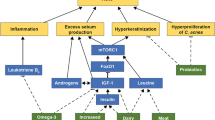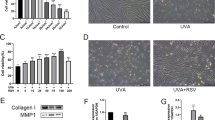Abstract
Inflammatory responses induced by Propionibacterium acnes are a major etiological factor in the pathogenesis of acne vulgaris. Schisandrin A, schisandrin B, and schisandrin C are the representative lignans of Schisandra chinensis (Turcz.) Baill. extract. Although anti-inflammatory effects of the lignans have been shown, their effects on acne-related inflammation caused by P. acnes have not been investigated and compared. We pretreated THP-1 human monocytic cells with 5, 10, and 20 μM schisandrin A, B, and C, and stimulated the cells with P. acnes. Schisandrin B and C inhibited the release of inflammatory cytokines at a concentration of 5 μM, while schisandrin A required a concentration of 10 μM to exert the effects. All of the schisandrins decreased the levels of toll-like receptor 2, and schisandrin B and C reduced the intracellular mRNA expression of the receptor gene. We also studied the influence of schisandrins on the MAPK signaling pathway. Schisandrin A suppressed the P. acnes-induced activation of JNK, while exerting only a weak effect on ERK and p38. Schisandrin B exerted a strong effect on p38, a lesser effect on ERK, and almost no effect on JNK. Schisandrin C inhibited the phosphorylation of all three proteins, especially ERK. Furthermore, the three lignans also prevented the nuclear translocation of NF-κB. These results contribute to our understanding of the mechanisms underlying the effects of the three lignans on P. acnes-induced inflammation and suggest that schisandrins might be developed as pharmacological agents for acne therapy.






Similar content being viewed by others
References
Cunliffe, W.J. 1986. Acne and unemployment. British Journal of Dermatology 115: 386.
Farrar, M.D., and E. Lngham. 2004. Acne: inflammation. Clinics in Dermatology 22: 380–384.
Leyden, J.J. 2003. A review of the use of combination therapies for the treatment of acne vulgaris. Journal of American Academy of Dermatology 49: 200–210.
Takeuchi, O., and S. Akira. 2010. Pattern recognition receptors and inflammation. Cell 140: 805–820.
Beylot, C., N. Auffret, F. Poli, J.P. Claudel, M.T. Leccia, P. Del Giudice, and B. Dreno. 2014. Propionibacterium acnes: an update on its role in the pathogenesis of acne. Journal of the European Academy of Dermatology & Venerology 28: 271–278.
Gambero, M., D. Teixeira, L. Butin, M.E. Ishimura, M. Mariano, A.F. Popi, and I.M. Longo-Maugeri. 2016. Propionibacterium acnes induces an adjuvant effect in B-1 cells and affects their phagocyte differentiation via TLR2-mediated mechanism. Immunobiology 221: 1001–1011.
Kim, J. 2005. Review of the innate immune response in acne vulgaris: activation of Toll-like receptor 2 in acne triggers inflammatory cytokine responses. Dermatology 211: 193–198.
Duan, Y.X., J.L. Cao, R.R. Wen, G.Y. Yang, J.X. Pu, H.D. Sun, W.L. Xiao, and G.P. Li. 2011. Dibenzocycolooctadiene lignans from Schisandra neglecta and their anti-HIV-1 activities. Journal of Asian Natural Products Research 77: 1800–1805.
Liu, H., H. Lai, X. Jia, J. Liu, Z. Zhang, Y. Qi, J. Zhang, J. Song, C. Wu, B. Zhang, and P. Xiao. 2013. Comprehensive chemical analysis of Schisandra chinensis by HPLC-DAD-MS combined with chemometrics. Phytomedicine 20: 1135–1143.
Chun, J.N., M. Cho, I. So, and J.H. Jeon. 2014. The protective effects of Schisandra chinensis fruit extract and its lignans against cardiovascular disease: a review of the molecular mechanisms. Fitoterapia 97: 224–233.
Alexander, J.S., and Y. Wang. 2012. Therapeutic potential of Schisandra chinensis extracts for treatment of hypertension. Introduction to: ‘antihypertensive effect of gomisin A from Schisandra chinensis on angiotensin II-induced hypertension via preservation of nitric oxide bioavailability’ by Park et al. Hypertension Research: official journal of the Japanese Society of Hypertension 35: 892–893.
Guo, M., Y. Lu, J. Yang, X. Zhao, and Y. Lu. 2016. Inhibitory effects of Schisandra chinensis extract on acne-related inflammation and UVB-induced photoageing. Pharmaceutical Biology 54: 2987–2994.
Ko, K.M., and B.Y. Lam. 2002. Schisandrin B protects against tert-butylhydroperoxide induced cerebral toxicity by enhancing glutathione antioxidant status in mouse brain. Molecular and Cellular Biochemistry 238: 181–186.
Panossian, A., and G. Wikman. 2008. Pharmacology of Schisandra chinensis Bail.: an overview of Russian research and uses in medicine. Journal of Ethnopharmacology 118: 183–212.
Szopa, A., R. Ekiert, and H. Ekiert. 2016. Current knowledge of Schisandra chinensis (Turcz.) Baill. (Chinese magnolia vine) as a medicinal plant species: a review on the bioactive components, pharmacological properties, analytical and biotechnological studies. Phytochemistry Reviews. https://doi.org/10.1007/s11101-016-9470-4.
Chen, Z., M. Guo, G. Song, J. Gao, Y. Zhang, Z. Jing, T. Liu, and C. Dong. 2016. Schisandrin B inhibits Th1/Th17 differentiation and promotes regulatory T cell expansion in mouse lymphocytes. International Immunopharmacology 35: 257–264.
Bartlova, M., L. Opletal, V. Chobot, and H. Sovova. 2002. Liquid chromatographic analysis of supercritical carbon dioxide extracts of Schisandra chinensis. Journal of Chromatography B Analytical Technologies in the Biomedical & Life Sciences 770: 283–289.
Sun, Y.X., Y.L. Cong, Y. Liu, B. Jin, L. Si, A.B. Wang, H. Cai, G.Y. Che, B. Tang, C.F. Wang, Z.Y. Li, and X.M. Zhang. 2014. Schiandrin A and B affect subventricular zone neurogenesis in mouse. European Journal of Pharmacology 740: 55–559.
Guo, L.Y., T.M. Hung, K.H. Bae, E.M. Shin, H.Y. Zhou, Y.N. Hong, S.S. Kang, H.P. Kim, and Y.S. Kim. 2008. Anti-inflammatory effects of schisandrin isolated from the fruit of Schisandra chinensis Baill. European Journal of Pharmacology 591: 293–299.
Leong, P.K., H.S. Wong, J. Chen, W.M. Chan, H.Y. Leung, and K.M. Ko. 2016. Differential action between schisandrin A and schisandrin B in eliciting an anti-inflammatory action: the depletion of reduced glutathione and the induction of an antioxidant response. PloS One 11: e0155879.
Park, S.Y., D.J. Park, Y.H. Kim, Y.H. Kim, S.G. Kim, K.J. Shon, Y.W. Choi, and S.J. Lee. 2011. Upregulation of heme oxygenase-1 via PI3K/Akt and Nrf-2 signaling pathways mediates the anti-inflammatory activity of Schisandrin in Porphyromonas gingivalis LPS-stimulated macrophages. Immunology Letters 139: 93–101.
Cai, Z., J. Liu, H. Bian, J. Cai, and G. Zhu. 2016. Suppression of P2X7/NF-κB pathway by Schisandrin B contributes to attenuation of lipopolysaccharide-induced inflammation responses in acute lung injury. Archives of Pharmacal Research 39: 499–507.
Checker, R., R.S. Patwardhan, D. Sharma, J. Menon, M. Thoh, H.N. Bhilwade, T. Konishi, and S.K. Sandur. 2012. Schisandrin B exhibits anti-inflammatory activity through modulation of the redox-sensitive transcription factors Nrf2 and NF-κB. Free Radical Biology & Medicine 53: 1421–1430.
Zeng, K.W., T. Zhang, H. Fu, G.X. Liu, and X.M. Wang. 2012. Schisandrin B exerts anti-neuroinflammatory activity by inhibiting the Toll-like receptor 4-dependent MyD88/IKK/NF-κB signaling pathway in lipopolysaccharide-induced microglia. European Journal of Pharmacology 692: 29–37.
Liu, N., J.X. Zheng, Y.S. Zhuang, Z.K. Zhou, J.H. Zhao, and L. Yang. 2017. Anti-inflammation effects of schisandrin B on LPS-stimulated BV2 microglia via activating PPAR-γ. Inflammation. https://doi.org/10.1007/s10753-017-0544-2.
Oh, S.Y., Y.H. Kim, D.S. Bae, B.H. Um, C.H. Pan, C.Y. Kim, H.J. Lee, and J.K. Lee. 2010. Anti-inflammatory effects of gomisin N, gomisin J and schisandrin C isolated from fruit of Schisandra chinensis. Bioscience Biotechnology & Biochemistry 74: 285–291.
Karin, M., and M. Delhase. 2000. The IκB kinase (IKK) and NF-κB: key elements of proinflammatory signaling. Seminars in Immunololy 12: 85–98.
Poulton, K., A. Rahman, and I. Giles. 2012. Examining how antiphospholipid antibodies activate intracellular signaling pathways: a systematic review. Seminars in Arthritis & Rheumatism 41: 720–736.
Lolis, M.S., W.P. Bowe, and A.R. Shalita. 2009. Acne and systemic disease. Medical Clinics of North America 93: 1161–1181.
De, N.E. 2001. The role of inflammatory and immunological mediators inperiodontitis and cardiovascular disease. Annals of Periodontology 6: 30–40.
Cailton, F., M. O’Connell, E.A. Eady, G.R. Jenkins, J.H. Cove, A.M. Layton, and A.P. Mountford. 2010. Interleukin-10 secretion from CD14+ peripheral blood mononuclear cells is downregulated in patients with acne vulgaris. British Journal of Dermatology 162: 296–303.
Kim, J., M.T. Ochoa, S.R. Krutzik, O. Takeuchi, S. Uematsu, A.J. Legaspi, H.D. Brightbill, D. Holland, W.J. Cunliffe, S. Akira, P.A. Sieling, P.J. Godowski, and R.L. Modlin. 2002. Activation of toll-like receptor 2 in acne triggers inflammatory cytokine responses. Journal of Immunology 169: 1535–1541.
Jung, M.K., S. Ha, J.A. Son, J.H. Song, Y. Houh, E. Cho, J.H. Chun, S.R. Yoon, Y. Yang, S.I. Bang, M. Kim, H.J. Park, and D. Cho. 2012. Polyphenon-60 displays a therapeutic effect on acne by suppression of TLR2 and IL-8 expression via down-regulating the ERK1/2 pathway. Archives of Dermatological Research 304: 655–663.
Vega, B., A. Jomard, and S. Michel. 2002. Regulation of human monocyte Toll-like receptor (TLR2) expression by adapalene. Journal of the European Academy of Dermatology and Venereology 16: 123–124.
Qin, M., A. Priouz, M.H. Kim, S.R. Krutzik, H.J. Garban, and J. Kim. 2014. Propionibacterium acnes induces IL-1β secretion via the NLRP3 inflammasome in human monocytes. Journal of Investigative Dermatology 134: 381–388.
Acknowledgements
This work was supported by the Industry-University-Institute collaboration of Baoshan District Committee of Science and Technology (No. 16-C-22), the General Financial Grant from the China Postdoctoral Science Foundation (2016M601532), the National Natural Science Foundation of China (No. 31600273), and Shanghai Inoherb Co. Ltd.
Author information
Authors and Affiliations
Corresponding authors
Ethics declarations
Conflict of Interest
The authors declare that they have no conflict of interest.
Rights and permissions
About this article
Cite this article
Guo, M., An, F., Wei, X. et al. Comparative Effects of Schisandrin A, B, and C on Acne-Related Inflammation. Inflammation 40, 2163–2172 (2017). https://doi.org/10.1007/s10753-017-0656-8
Published:
Issue Date:
DOI: https://doi.org/10.1007/s10753-017-0656-8




